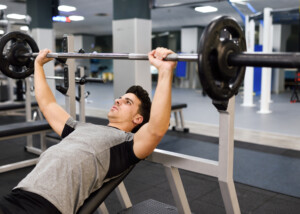
If you have a thoracic aortic aneurysm and are crushed at hearing “avoid lifting weights,” there is hope: Hundreds training, for building muscle.
If you’ve been diagnosed with a thoracic aortic aneurysm, your doctor may have warned you not to lift weights.
This all-encompassing restriction for those with a thoracic aortic aneurysm ensures that there will never be a blood pressure spike from any heavy lifting.
Thoracic aortic aneurysm and building muscle can be in the same sentence with “hundreds training.”
Chances are pretty high that your doctor is not aware of a weightlifting format called “hundreds training.”
Hundreds training is ideal for people who, due to medical conditions (including thoracic aortic aneurysm), cannot or should not lift heavy weights.
Can it be safe, then, for people with a thoracic aortic aneurysm to lift weights?
According to the International Registry of Acute Aortic Dissections website:
For patients who are very much interested in maintaining some sort of weight lifting program, choosing sets of repetitive light weights appears to make more sense than permitting heavy weight lifting.
Hundreds training can actually build lean muscle tissue. If you have an aortic aneurysm and, in the past, strained with heavy weights in the name of building muscle or shaping your body, you can still achieve these results – with hundreds training.
Granted, if you want to place in a bodybuilding contest, you’re going to need a lot more than the hundreds training protocol.
- But this isn’t about getting the look of a bodybuilder.
- It’s about increasing lean muscle mass — which of course, always results in a better looking and fitter body.
Hundreds training will not bulk you up or make you look like a powerhouse.

Shutterstock/wavebreakmedia
But assuming that you want to lift weights to have a sleek, muscular look, hundreds training should work very well for you, and will not contraindicate a thoracic aortic aneurysm.
The “How to” of Hundreds Training
The basic premise of hundreds training is to use a load that is 20 to 30 percent of your 8-12 rep max effort.
The rule of “don’t lift weights” for people with aortic aneurysm assumes that any strength training they do would cause a big spike in blood pressure.
Hundreds training won’t cause a major spike in blood pressure because 20-30 percent of your 8-12 rep max is not heavy enough.
Example: Shoulder Press
Let’s use the shoulder press machine as an example. With a load that’s 20-30 percent of 8-12 rep max, push it up 50 times.

Shutterstock/CandyBox Images
This may not be possible; you might make it only to 40. Just lift the weight till you can’t anymore.
This muscle failure will not spike blood pressure, even though it will hurt like mad.
People with a thoracic aortic aneurysm should never hold their breath while lifting weights, and should always exhale on the push or pull phase.
However many reps you complete for this first attempt, subtract that from 100, and that’s how many seconds you rest till you resume.
If you completed 45 reps, you rest 55 seconds, then see how many more you can do, which will certainly be less than 45.
Let’s say it’s 25. So now, you’ve completed 70 reps thus far. This means you rest 30 seconds (100 minus 70 equals 30).
Go again. Each time you have to stop, whatever number of reps you have left, is the number of seconds you rest.
By the time you’re done your muscles will be pumped like never before, and the “pain” will be searing.
This is a safe way to lift weights for people with aortic aneurysm, because the resistance doesn’t require the straining that doctors warn against.
Muscle burn is not the same as straining, and comes from lactic acid buildup, which results from many reps. Rest five to seven minutes in between hundreds routines.
Three sessions per week (45 minutes each) will provide a superb, safe weightlifting workout for people with a thoracic aortic aneurysm who wish to build muscle.
Before embarking on this regimen, you should explain it to your cardiologist.









































